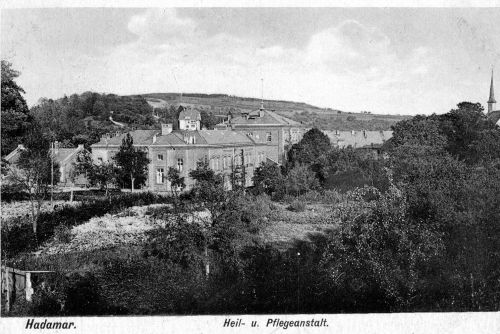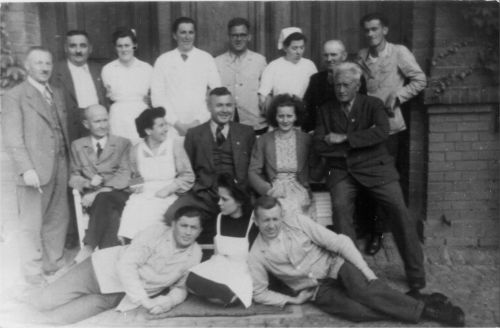Hadamar

Hadamar - T4 Institute (Tall Trees Private Archive)
Located on a hill, the Mochsberg, overlooking the town of Hadamar, near Limburg-an-der-Lahn in Hesse, a Korrigenden-Anstalt (Correction Institution for Released Prisoners) was founded in 1883. As the number of mentally disturbed persons in Germany increased in the early years of the 20th century, additional medical facilities were considered necessary. Thus in 1906, the Korrigenden-Anstalt in Hadamar was converted to a mental institution. By 1930, the home contained 320 patients. As decreed by Nazi law, from 1934, nursing costs for mental patients were reduced. By 1936, the mental homes had become overcrowded, and conditions worsened as a result of the reduced quantity and quality of food supplies. The building had been designed to accommodate 250 patients, but by 1939, about 600 inmates were crowded into cramped quarters.
During late August 1939, following Hadamar's designation as a military hospital, patients were distributed to surrounding mental homes. However, between November 1940, and January 1941, the sickrooms were converted into quarters for the medical and administrative staff of the new T4 Hadamar euthanasia killing centre. The staff had been transferred from Grafeneck, following the closure of that facility.
Rooms to receive arriving patients were located on the first floor. A gas chamber disguised as a shower room was installed in the basement of the building, together with a crematorium with two ovens which were attached to a chimney. Gas entered the chamber from an adjacent room through pipes with holes punched in them. Large grey busses arrived daily carrying victims from nearby mental homes at Herborn, Weilmunster, Kiedrich, Idstein, Nassau, Langenfeld, Andernach, Wiesloch and Weinsberg. From the garage the victims were conducted through the so-called 'Schlauch' - sluice - which was a narrow fenced-in path - to the extermination building. The Hadamar 'sluice' became the model for the so-called 'Tube' which was later used at Belzec, Sobibor and Treblinka, the three Nazi death camps in Poland, as part of Aktion Reinhardt.
Signs on the road leading to Hadamar warned that the danger of epidemics prohibited entry, but the chimney's smoke and the smell could not disguise the true nature of the operation from local inhabitants. From the commencement of gassing operations on 13 January 1941, until August of the same year, approximately 100 victims were killed every day.

T4 Personnel at Hadamar 1942 including Alfons Klein in the middle of the photo
On August 24, 1941, the T4 euthanasia killings at Hadamar was suspended on Hitler's orders. The Bishop of Limburg had protested that pupils of schools in Hadamar called the Gekrat buses, 'killing crates' and threatened each other with the words, 'You'll end up in the Hadamar ovens!' People were saying, 'Germany cannot win the war, if there is still a just God.' The installations in the cellar were dismantled and other rooms converted back to sickrooms. Many of the staff were ordered to the East, to put what they had learned in Hadamar to practical use in the Aktion Reinhardt death camps of Belzec, Sobibor and Treblinka. A number of key personnel such as Kurt Bolender, Karl Frenzel, Hubert Gomerski, Gottlieb Hering, Josef Hirtreiter, Willi Mentz, August Miete, Christian Wirth all served in Hadamar, and carried on murdering people, this time on a gigantic scale.
Killings at Hadamar recommenced in 1942, as part of the second phase of the euthanasia programme, the so-called 'wild euthanasia.' Now the victims were murdered by administering lethal doses of barbiturates or morphine -scopolamine injections. While initially there had been some pretence of medical deliberations before deciding on a patient's fate, with the arrival of Polish and Russian workers in 1944, mostly diagnosed as 'tubercular' despite a complete lack of medical examination until after their deaths, the killing became automatic. When pressed at a post-war trial, the chief female nurse finally admitted that what had occurred could only be described as murder.
On April 15, 1943, a ward for Jewish children of mixed marriages was created, disguised as an 'educational home.' This ward would eventually receive children from all parts of the Reich. The exact number of Jewish children transferred to Hadamar during 1943, and 1944, is not known, but it is certain that most were healthy, and they were sent to Hadamar because they were partly Jewish. As the deportation policy exempted these children, the bureaucracy of the Ministry of the Interior, not the SS or the police agencies, decided to destroy at least those children within its control that the regime defined as Jewish. At Hadamar these healthy children were murdered with lethal injections.
Until late August 1942, bodies had been buried at the town's cemetery, but from September of that year, mass graves located behind the building were used. During October 1944, more than 700 inmates were crowded together at the home. On March 26, 1945, American forces captured the town of Hadamar and in the institute's pharmacy 10 kilograms of the barbiturates 'Veronal' and 'Luminal' used to sedate or kill the victims were found.
Members of Hadamar's personnel were put on trial in 1945, in Wiesbaden and in 1947, in Frankfurt am Main. At the Frankfurt am Main trial, a burly member of the Death's Head Verbande, called Hubert Gomerski sat in the massed dock. As a mere crematorium stoker, posted from the Berlin Gestapo's recruiting centre, Columbia House, he was acquitted. But in August 1950, Gomerski again faced the Schwurgericht, where it was proved that he left Hadamar for Lublin in January 1942. Eventually he became the shooting expert at the Sobibor death camp. He was known as 'the doctor' because of his past experience in handling the sick, and his speciality was braining the half-dead with a steel water-can as they were taken off the trains.
Another of these 'doctors,' the Treblinka NCO, Josef 'Sepp' Hirtreiter, who had also graduated under Christian Wirth at Hadamar, was unearthed by the Frankfurt Schwurgericht in 1950. He too, had previously been on trial for euthanasia activities in 1947, when the court had failed to identify him with the 'Hirtreiter,' named at the Polish Treblinka inquiry during 1945, as a specialist in killing children without wasting ammunition.
At the Hadamar trial held in October 1945, Colonel Leon Jaworski described the murder of patients by their physicians in the following terms:
'Oh, what a vicious falsehood, what a terrible thing, what an evil and wicked thing to do to a person who is already suffering and already carrying burdens, to build up the false hope that sunshine was to enter their hearts. They told them they would be given medication that would help them. Oh yes, they were given medications, medications of poison that gripped their heart and closed their eyelids still; that is the sort of medications they were given.'
On October 15, 1945, chief prosecutor Leon Jaworski, who would gain fame during the 1970's, as Watergate Special Prosecutor, won convictions for all those accused. The six-man US Military Tribunal prescribed death by hanging for Hadamar's chief administrator Alfons Klein, and two male nurses Heinrich Ruoff and Karl Willig. Because of his advanced age, chief physician Adolf Wahlmann received a life sentence, which was eventually commuted. Two Hadamar administrative staff, Adolf Merkle and Phillipp Blum received sentences of 35 and 30 years respectively, while the only female defendant Irmgard Huber received the lightest sentence that of 25 years' imprisonment. On March 14, 1946, Klein, Ruoff and Willig went to the gallows.
During the 1950's all War Criminals were pardoned and modern-day investigations established a figure of at least 10,072 victims gassed at Hadamar. To this figure must be added a minimum of 4,000 other deaths killed as a result of the 'wild euthanasia.' In 1983, the Hadamar Memorial was installed at the infamous building, which to this day, is still in use as a mental facility.
Sources
Friedlander, Henry. The Origins of Nazi Genocide: From Euthanasia to the Final Solution, University of North Carolina Press, Chapel Hill, 1995.
Kogon, Eugen; Langbein, Hermann; Rückerl, Adalbert; eds. Nazi Mass Murder, Yale University Press, New Haven and London, 1993
Lifton, Robert Jay. The Nazi Doctors – Medical Killing and the Psychology of Genocide, Papermac, London, 1990.
G. Reitlinger, The Final Solution, published by Sphere Books Ltd, London 1971
Law Reports of Trials of War Criminals, The United Nations War Crimes Commission, Volume 1. London, HMSO, 1947.
www. Holocaustresearchproject.org - online resource
www. Jewish Virtual Library - Nazi War Crimes Trials: Hadamar Trial
Photographs: Tall Trees Private Archive, Gedenkstatte Hadamar
© Holocaust Historical Society 2018

